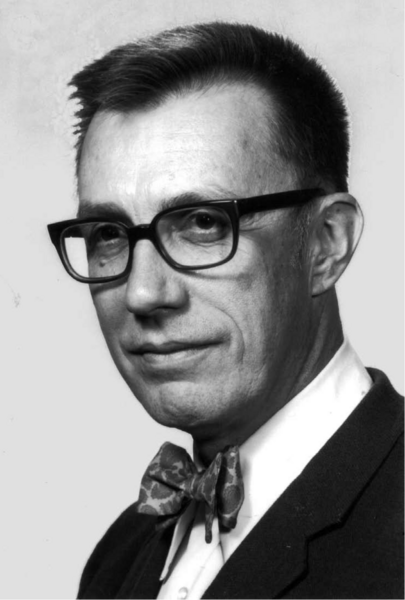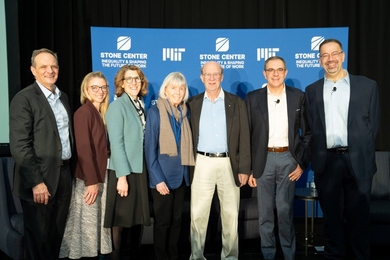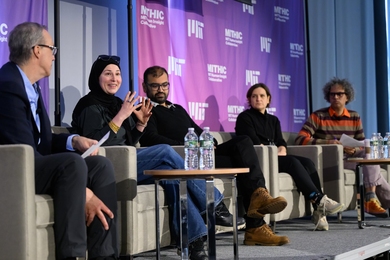Robert V. Whitman SM ’49, ScD ’51, a world-renowned geotechnical engineer and expert on earthquakes in MIT’s Department of Civil and Environmental Engineering (CEE), died on Feb. 25. He was 84.
With the exception of two years spent in military service, Whitman was with CEE from 1948 until his retirement in 1993, and he remained an active member of the MIT community for many more years as a professor emeritus.
“Bob was a tremendous role model as a faculty member, renowned for his ability to clarify the complexities of soil mechanics and earthquake engineering, and for his commitment to serve society at-large through leadership in professional organizations,” said CEE Department Head Andrew Whittle.
Born in Edgewood, Pa., he majored in civil engineering at Swarthmore College with a concentration in structures and later studied structural dynamics with Professor Charles Norris at MIT. Then, for his ScD research, he chose to work with Professor Donald Taylor on the effects of nuclear explosives on underground structures. While working with Taylor’s group, he met his future wife, Elizabeth “Betsy” Cushman, and the two were married in June 1954.
From 1954 to 1956, Whitman served in the Navy as an officer in the Civil Engineer Corps stationed at Pearl Harbor, Hawaii. Afterward, he resumed his research into the effects of weapons and protective construction and served on the Air Force’s advisory panel for the earliest hardened missile complexes. In the 1960s, he worked on developing stable foundations for long-range tracking radars, research that led him to become a leading expert in the new discipline of soil dynamics.
Whitman then moved into earthquake engineering, initially through a joint study with Professor Harry Seed of the University of California at Berkeley. Research followed on various aspects of building vulnerability, liquefaction, soil-structure interaction, design of earth-retaining structures and stability of earthen dams and dikes.
During his transition from soil dynamics to earthquake engineering, Whitman and MIT Professor Bill Lambe co-wrote the acclaimed textbook Soil Mechanics (John Wiley & Sons, 1969). “Of all the things I’ve done, I’m probably proudest of that book,” Whitman said in an oral history published by the Earthquake Engineering Research Institute (EERI) in 2009.
Reducing earthquake hazards were a major focus for Whitman during the 1970s, when he helped develop the Massachusetts State Seismic Code and worked on framing the National Earthquake Hazards Reduction Program.
Then, in 1979, Whitman took a sabbatical at Cambridge University, where he was drawn to centrifuge research. He subsequently helped to introduce centrifuge testing to the U.S. geotechnical community. Whitman also pioneered the study of risk-based geotechnical engineering; he presented his work on risk analysis at the Terzaghi Lecture in 1981 at the American Society of Civil Engineer’s (ASCE) National Convention.
Over the years, Whitman served on many scientific and government advisory boards, including the Air Force Scientific Advisory Board and the National Research Council’s Commission on Engineering and Technical Systems. He helped form the Federal Emergency Management Agency's five-year Earthquake Hazard Mitigation Plan and chaired the National Research Council’s committee that produced the influential report Liquefaction of Soils During Earthquakes (1985).
He also made significant contributions to the Applied Technology Council’s report Tentative Provisions for the Development of Seismic Regulations for Buildings, which provided the first national earthquake hazard maps. He chaired the National Research Council panel that proposed a methodology for estimating losses from earthquakes and led the committee that developed a nationally applicable standardized methodology (called HAZUS) for estimating potential losses from earthquakes, floods and hurricanes.
Whitman received numerous honors for his contributions to the field. The EERI inducted him in 1972, and he later served as the society’s first president from outside California. He was elected to the National Academy of Engineering in 1975. The ASCE gave him the Terzaghi Award for outstanding contributions to knowledge in the fields of soil mechanics, subsurface and earthwork engineering, and he received the EERI's George W. Housner Medal for sustained leadership and contributions to earthquake engineering.
At MIT, Whitman undertook numerous leadership roles, notably serving as parliamentarian at Institute faculty meetings during the tumultuous Vietnam War-era student uprisings. Known for his devotion to teaching and research, he will also be remembered by many for his personal warmth. He and his wife frequently hosted graduate students for meals and annually celebrated the end of the school year with a party. In his hometown of Lexington, Mass., Whitman was also known for helping to clarify issues at Town Meeting, where he served as an elected official for decades.
In addition to his wife of 57 years, Whitman is survived by two daughters and four grandchildren. Another daughter predeceased him. A memorial service was to be held at the Church of Our Redeemer in Lexington on March 1 at 1 p.m. Donations may be made in his memory to Citizens for Lexington Conservation Inc., P.O. Box 292, Lexington, MA 02420-0003 or to the Chebeague and Cumberland Land Trust.
With the exception of two years spent in military service, Whitman was with CEE from 1948 until his retirement in 1993, and he remained an active member of the MIT community for many more years as a professor emeritus.
“Bob was a tremendous role model as a faculty member, renowned for his ability to clarify the complexities of soil mechanics and earthquake engineering, and for his commitment to serve society at-large through leadership in professional organizations,” said CEE Department Head Andrew Whittle.
Born in Edgewood, Pa., he majored in civil engineering at Swarthmore College with a concentration in structures and later studied structural dynamics with Professor Charles Norris at MIT. Then, for his ScD research, he chose to work with Professor Donald Taylor on the effects of nuclear explosives on underground structures. While working with Taylor’s group, he met his future wife, Elizabeth “Betsy” Cushman, and the two were married in June 1954.
From 1954 to 1956, Whitman served in the Navy as an officer in the Civil Engineer Corps stationed at Pearl Harbor, Hawaii. Afterward, he resumed his research into the effects of weapons and protective construction and served on the Air Force’s advisory panel for the earliest hardened missile complexes. In the 1960s, he worked on developing stable foundations for long-range tracking radars, research that led him to become a leading expert in the new discipline of soil dynamics.
Whitman then moved into earthquake engineering, initially through a joint study with Professor Harry Seed of the University of California at Berkeley. Research followed on various aspects of building vulnerability, liquefaction, soil-structure interaction, design of earth-retaining structures and stability of earthen dams and dikes.
During his transition from soil dynamics to earthquake engineering, Whitman and MIT Professor Bill Lambe co-wrote the acclaimed textbook Soil Mechanics (John Wiley & Sons, 1969). “Of all the things I’ve done, I’m probably proudest of that book,” Whitman said in an oral history published by the Earthquake Engineering Research Institute (EERI) in 2009.
Reducing earthquake hazards were a major focus for Whitman during the 1970s, when he helped develop the Massachusetts State Seismic Code and worked on framing the National Earthquake Hazards Reduction Program.
Then, in 1979, Whitman took a sabbatical at Cambridge University, where he was drawn to centrifuge research. He subsequently helped to introduce centrifuge testing to the U.S. geotechnical community. Whitman also pioneered the study of risk-based geotechnical engineering; he presented his work on risk analysis at the Terzaghi Lecture in 1981 at the American Society of Civil Engineer’s (ASCE) National Convention.
Over the years, Whitman served on many scientific and government advisory boards, including the Air Force Scientific Advisory Board and the National Research Council’s Commission on Engineering and Technical Systems. He helped form the Federal Emergency Management Agency's five-year Earthquake Hazard Mitigation Plan and chaired the National Research Council’s committee that produced the influential report Liquefaction of Soils During Earthquakes (1985).
He also made significant contributions to the Applied Technology Council’s report Tentative Provisions for the Development of Seismic Regulations for Buildings, which provided the first national earthquake hazard maps. He chaired the National Research Council panel that proposed a methodology for estimating losses from earthquakes and led the committee that developed a nationally applicable standardized methodology (called HAZUS) for estimating potential losses from earthquakes, floods and hurricanes.
Whitman received numerous honors for his contributions to the field. The EERI inducted him in 1972, and he later served as the society’s first president from outside California. He was elected to the National Academy of Engineering in 1975. The ASCE gave him the Terzaghi Award for outstanding contributions to knowledge in the fields of soil mechanics, subsurface and earthwork engineering, and he received the EERI's George W. Housner Medal for sustained leadership and contributions to earthquake engineering.
At MIT, Whitman undertook numerous leadership roles, notably serving as parliamentarian at Institute faculty meetings during the tumultuous Vietnam War-era student uprisings. Known for his devotion to teaching and research, he will also be remembered by many for his personal warmth. He and his wife frequently hosted graduate students for meals and annually celebrated the end of the school year with a party. In his hometown of Lexington, Mass., Whitman was also known for helping to clarify issues at Town Meeting, where he served as an elected official for decades.
In addition to his wife of 57 years, Whitman is survived by two daughters and four grandchildren. Another daughter predeceased him. A memorial service was to be held at the Church of Our Redeemer in Lexington on March 1 at 1 p.m. Donations may be made in his memory to Citizens for Lexington Conservation Inc., P.O. Box 292, Lexington, MA 02420-0003 or to the Chebeague and Cumberland Land Trust.






